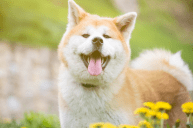Meet this Pomeranian look-alike!
Despite being similar in appearance to the American Eskimo Dog, Pomeranian, and Samoyed breeds, the Japanese Spitz dog breed has its own history. It is recognized as a separate breed by many kennel clubs around the world, including the Japanese Kennel Club. These small dogs make good watchdogs and are a healthy breed with a long life expectancy perfect for dog shows, companionship, and non-sporting pastimes.
History Of The Japanese Spitz
The Japanese Spitz is thought to be descended from white German Spitz dogs introduced to Japan around 1920 via Siberia and China. The breed's entire history is unknown since the archives were lost during World War II. However, it is understood that the Japanese Spitz was first shown in 1921 at a Tokyo fair, and two white Spitz breeds were imported from Canada in 1925. In the mid 1920s and mid 1930s, white spitz imports from Canada, the United States, Australia, and China included the white Klein Wolfsspitz (Keeshond). As a result of crossbreeding, the offspring developed the Japanese Spitz breed standard, which the Japan Kennel Club established in 1948.
Global kennel clubs worldwide eventually recognized Japanese Spitzes as their own breed, but many of these kennel clubs also differ in their breed requirements, especially when it comes to the size of these dogs. The American Kennel Club (AKC) is an exception since it does not consider the Japanese Spitz as a distinct breed due to its similarity to the American Eskimo Dog. The breed's reputation continues to expand around the world.
Appearance
Japanese Spitz dogs are similar to White Pomeranians in appearance, though there are some significant differences. They are little dogs with thick, pure white coats with a mane-like design around their necks. Like those of other spitz dogs, their tails curve down their back in a glamorous fur plume. A pointed muzzle resembles a rat, and they have a black nose, black eye rims, and ears that stand high and alert.
Personality
Japanese Spitz dogs are excellent with children due to their playful and gentle disposition. Because of their small size, they are less likely to trip children or play rough unintentionally. Most children would enjoy having a Japanese Spitz as a caring, protective playmate. Japanese Spitz dogs get along well with other household pets and are loving companion dogs to their owners. They are not mean by nature, but they make outstanding watchdogs.
Training & Exercise
The Japanese Spitz is a highly trainable breed due to its intelligence and eagerness to please. Since they seek companionship and contact with their owners, they can develop problem behaviors if left alone for extended periods of time. Positive reinforcement, training classes, and early socialization are highly encouraged for Japanese Spitz puppies. Without training and socialization, they will take it upon themselves to learn new things, but not the kinds of things you want them to learn. Similarly, The Japanese Spitz thrives in large open areas, such as farms and ranches, but also in small spaces, such as homes. They can benefit physically and emotionally from a fun, social run outside or at least a daily walk.
Grooming
The Japanese Spitz has a dense double coat of white fur. The undercoat, which they shed twice a year, is thick and generous, with a longer outer coat. In around 2 to 3 weeks, the whole undercoat is shed. They will need regular brushing during this time to remove the fur, but the hair will eventually end up on your clothing, furniture, and floor. However, this breed is low maintenance for most of the year, requiring only routine grooming and infrequent bathing until the dog gets into something dirty. Bathing them too much will cause them to lose their natural oils and irritate their skin, so washing them once a season is adequate.
Health
Spitzes are a healthy, active breed with a lifespan of 12 to 14 years. They are not prone to many health issues, though some cases of Patellar Luxation (a disorder where kneecaps become dislocated) have been discovered in the breed. They may also have runny eyes from time to time, and if they are bathed too often, their skin may become raw.
Share your Japanese Spitz stories on the Wide Open Pets Facebook page!




